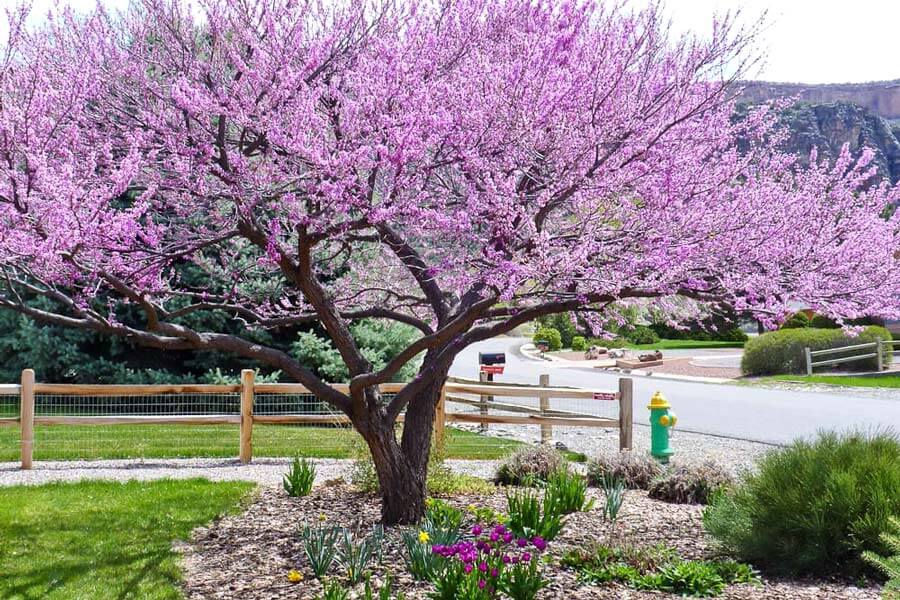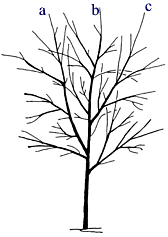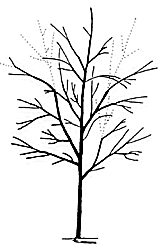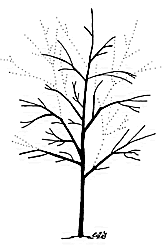Structural trimming is essential for the wellbeing of any tree. It encourages the growth of healthy and sturdy trees in urban landscapes. When executed properly, it can enhance the longevity and safety of your tree.
Structural pruning is about improving the branch architecture within a tree’s crown area to create a central and stronger leading stem with a network of adequately spaced branches of lesser diameter growing alongside.
The overall purpose of structural pruning is to prolong the lifespan of your landscape or yard tree.
What we cover
ToggleWhat is structural pruning?
Structural pruning is the systematic reduction or removal of a tree’s competing branches within the crown area to force growth into a selected leader stem, boosting the tree’s stability, health, and aesthetics. During structural pruning, an arborist performs reduction cuts on several large branches, including removing those with defects to give the tree better stability and avoid premature tree failure1, which can endanger human lives and property.
Benefits of structural pruning include:
- Structural pruning creates a well-balanced and more enjoyable tree.
- Structural pruning allows the crown to grow bigger and better, preserving it in the process.
- It increases tree longevity.

Want a shortcut?
The fastest and easiest way to get 3 Estimates from the most affordable tree services near you would be by using this FREE service.
GoTreeQuotes quickly matches you with the three tree surgeons voted #1 by previous users in your area.
- Scroll up to the top of the page and enter your ZIP Code in the blue form at the top of the page.
- Give us a few details about your tree trimming or removal job, plus some contact information.
- Your tree details are forwarded on to the closest three tree services, all voted best priced who will also price your tree job
Objectives of structural pruning
Structural pruning is a low-cost tree maintenance approach that aims to create a landscape tree structure similar to the trees growing in forest conditions. The objective is to create a safer and more stable tree that is less susceptible to wind damage, drought, and extreme temperatures.
We will use the images below2 as an example to discuss the impact of both light and moderate structural pruning on a branch-heavy tree.
Problem
The stems (a, b, and c) on the young trees in Image 1 are codominant, and they compete for crown leadership, which can threaten the tree’s stability as it grows older. Multiple leader stems increase the tree aspect ratio (the ratio of branch diameter to trunk diameter), which makes the tree more prone to failure than trees with one leader stem and a lower aspect ratio.
Before

After

Solution
Using reduction cut to reduce the size of stems ‘a’ and ‘c,’ channels more growth into the selected leader stem ‘b,’ and restricts growth on stems ‘a’ and ‘c.’ This allows ‘b’ to evolve into the dominant trunk by receiving more sunlight and nutrition, thus reducing the tree aspect ratio.
Before

After follow up prune

Phase 2: Moderate follow-up prune
Moderate pruning is comparable to light pruning. However, almost half of the tree foliage is removed to balance the tree, and enhance its aesthetics. You can use this more forceful approach if you want to leave the tree unpruned for several years or do not intend to prune the tree again.
Main steps in structural pruning.
The main steps in implementing a structural pruning program include the following:
Identify the central leader in the crown structure.
Establish the stem with the lowest aspect ratio, i.e., the largest stem within the crown branch network that fits the criteria of a leader stem. Your selected stem should be:
- In the town center, not off to the side.
- Upright, but it doesn’t have to be straight.
- Free from any form of damage, including lacerations, cavities, and human-inflicted wounds.
- Healthy and without deformities that can compromise its strength.
Identify the competing leader stems within the crown structure.
You need to ascertain the stems and branches within the branch network competing with the dominant stem.
Prune and space the competing stems.
At this stage, you perform structural pruning to potentially weak stems to redistribute the weight within the crown. You can remove around 60 to 70% of the foliage and flowers of a large branch on a young to a medium-aged tree to subordinate it.
This is done by:
- Removing competing or defective branches.
- Subordinating lengthy stems and branches with aggressive growth.
- Cutting thick foliage on the higher overhanging branches of the tree.
Identify the branches below the permanent canopy.
You must prevent the lower branches from excessive growth by performing aggressive pruning to limit their size to about a quarter of the trunk diameter.
When to prune for structure?
Pruning for structure is a process that you should perform periodically to improve the tree’s architecture as it grows over time.
How early?
Although, the best time to begin performing reduction cuts on by our tree varies. Experts recommend that you start within the first five years3 after planting or when your tree is less than 20 inches in diameter to establish a sound structure early in the tree’s lifecycle.
How late?
Although, young, healthy trees thrive better after experiencing substantial amounts of live branch removal. You can prune tree species that grow extremely large at maturity to boost their longevity and prevent tree failure.
How often?
Arborists recommend that you perform structural pruning every few years during your tree lifespan to stimulate extra growth in the leader stem. You can prune fast-growing trees every two to three years.
Can you do structural pruning for trees of all ages?
Yes, you certainly can. You can perform structural pruning on trees of all ages depending on the tree species’ characteristics, growth rate, and landscape environment. Structural pruning typically starts early in a tree’s life cycle. It is expected to continue throughout the tree’s lifespan to reduce the risk of potential failure and establish an excellent and robust structure at maturity.
Can you DIY or hire a pro?
Structural pruning is a technical procedure requiring plenty of tree pruning experience and skills to perform correctly. Although, you can DIY. Hiring an arborist is the most sensible option if you want to get the best out of your tree. A certified arborist can provide references for successful jobs done elsewhere. He also has the proper equipment to prune your tree without harming it. Most important, select an arborist with liability insurance to pay for any damage to your beloved tree during the procedure.
What to expect after structural pruning?
You can expect your tree to enjoy a myriad of benefits throughout its lifetime after structuring pruning is completed. They include:
- Lower susceptibility to storm, wind, and snow damage.
- Widely-spaced branches resulting in improved access to sunlight.
- Reduced risk of disease and pests.
- Lower long-term tree maintenance costs.
- Improved aesthetics and appearance.
- Longer lifespan.
- Edward F. Gilman, Brian Kempf, Jim Clark, and Nelda Matheny, (2019) Structural pruning shade trees. <https://www.seattle.gov/Documents/Departments/Trees/PlantingAndCare/Pruning/GILMAN_Structural_pruning_ISA_symposium.pdf> Accessed: 18-03-2024
- University of Florida, (2020) Structural pruning: the essence of tree care. <https://hort.ifas.ufl.edu/woody/structural-pruning-flash.shtml#:~:text=Structural%20pruning%20in%20the%20landscape,competing%20leaders%20using%20reduction%20cuts.%C2%A0> Accessed: 18-03-2024
- Lindsey Purcell, (2015) Tree Pruning Essentials. <https://extension.purdue.edu/extmedia/fnr/fnr-506-w.pdf> Accessed: 18-03-2024













